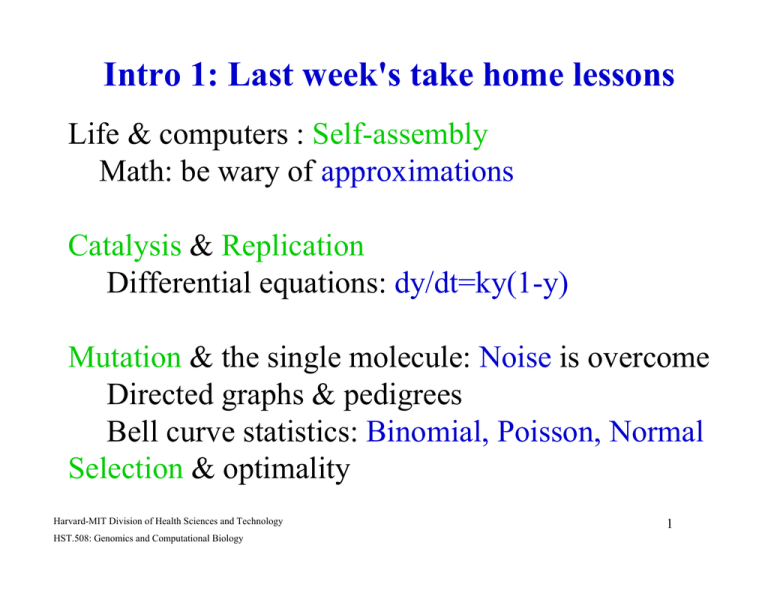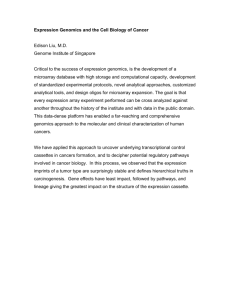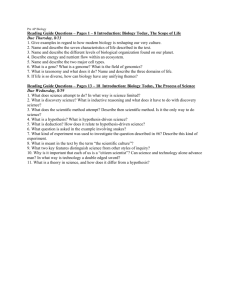Intro 1: Last week's take home lessons
advertisement

Intro 1: Last week's take home lessons Life & computers : Self-assembly Math: be wary of approximations Catalysis & Replication Differential equations: dy/dt=ky(1-y) Mutation & the single molecule: Noise is overcome Directed graphs & pedigrees Bell curve statistics: Binomial, Poisson, Normal Selection & optimality Harvard-MIT Division of Health Sciences and Technology HST.508: Genomics and Computational Biology 1 Intro 2: Today's story, logic & goals Biological side of Computational Biology •Elements & Purification Systems Biology & Applications of Models Life Components & Interconnections Continuity of Life & Central Dogma Qualitative Models & Evidence Functional Genomics & Quantitative models Mutations & Selection 2 Elements For most NA & protein backbones: C,H,N,O,P,S 6+13 Useful for many species: Na, K, Fe, Cl, Ca, Mg, Mo, Mn, Se, Cu, Ni, Co, Si 3 From atoms to (bio)molecules H2O CH4 NH3 H2S PH3 H2 , O2 C60 N2 Sn H+ , OH­ CO3NO3SO4-- Mg++ K+PO4-- Na+ Gas Elemental Salt 4 Purify Elements, molecules, assemblies, organelles, cells, organisms Clonal growth chromatography 5 Purified history Pre 1970s: Column/gel purification revolution Mid-1970s: Recombinant DNA brings clonal (single-step) purity. 1984-2002: Sequencing genomes & automation aids return to whole systems. 6 Intro 2: Today's story, logic & goals Biological side of Computational Biology Elements & Purification •Systems Biology & Applications of Models Life Components & Interconnections Continuity of Life & Central Dogma Qualitative Models & Evidence Functional Genomics & Quantitative models Mutations & Selection 7 "A New Approach To Decoding Life: Systems Biology" Ideker et al 2001 (http://arep.med.harvard.edu/pdf/Ideker01b.pdf) 1. Define all components of the system. 2. Systematically perturb and monitor components of the system (genetically or environmentally). 3. Refine the model such that its predictions most closely agree with observations. 4. New perturbation experiments to distinguish among model hypotheses. 8 Systems biology critique An old approach. New spins: 1. “all components” 2. “Systematically perturb” Unstated opportunities? 3. Refine the model without overfitting. Methods to recapture unautomated data. Explicit(automatic?) logical connections. 4. Optimization of new perturbation experiments & technologies. Automation, ultimate applications, & synthetics as 9 standards for: search, merge, check Transistors > inverters > registers > binary adders > compilers > application programs 10 Spice simulation of a CMOS inverter(figures) (http://et.nmsu.edu/~etti/spring97/electronics/cmos/cmostran.html) Why? #0. Why sequence the genome(s)? To allow #1,2,3 below. #1. Why map variation? #2. Why obtain a complete set of human RNAs, proteins & regulatory elements? #3. Why understand comparative genomics and how genomes evolved? To allow #4 below. #4. Why quantitative biosystem models of molecular interactions with multiple levels (atoms to cells to organisms & populations)? To share information. Construction is a test of understanding & to make useful products. 11 Grand (& useful) Challenges A) From atoms to evolving minigenome-cells. • Improve in vitro macromolecular synthesis. • Conceptually link atomic (mutational) changes to population evolution (via molecular & systems modeling). • Novel polymers for smart-materials, mirror-enzymes & drug selection. B) From cells to tissues. • Model combinations of external signals & genome-programming on expression. • Manipulate stem-cell fate & stability. • Engineer reduction of mutation & cancerous proliferation. • Programmed cells to replace or augment (low toxicity) drugs. C) From tissues to systems • Programming of cell and tissue morphology. • Quantitate robustness & evolvability. • Engineer sensor-effector feedback networks where macro-morphologies determine the functions; past (Darwinian) or future (prosthetic). 12 Intro 2: Today's story, logic & goals Biological side of Computational Biology Elements & Purification Systems Biology & Applications of Models •Life Components & Interconnections Continuity of Life & Central Dogma Qualitative Models & Evidence Functional Genomics & Quantitative models Mutations & Selection 13 Number of component types (guesses) Mycoplasma Worm Bases .58M >97M Human 3000M (http://www.nature.com/cgi-taf/DynaPage.taf?file=/nature/journal/v409/n6822/full/409860a0_fs.html) DNAs Genes 1 .48k 7 >19k 25 34k-150k >30k >50k 959 .2-3M .3-10M 1014 (http://www.ensembl.org/Genesweep/) RNAs .4k Proteins .6k Cells 1 14 From monomers to polymers Complementary surfaces Watson-Crick base pair (Nature April 25, 1953) (http://www.sil.si.edu/Exhibitions/Science-and-the-Artists-Book/bioc.htm#27) 15 Nucleotides dATP rATP 16 The simplest amino acid component of proteins Glycine Gly G config(glycine,[ substituent(aminoacid_L_backbone), substituent(hyd), linkage(from(aminoacid_L_backbone,car(1)), to(hyd,hyd(1)), Klotho (http://www.ibc.wustl.edu/klotho) nil,single)]). Smiles String: [CH2]([NH3+])[C](=[O])[O-] 17 20 Amino acids of 280 T www.people.virginia.edu/~rjh9u/aminacid.html 18 www-nbrf.georgetown.edu/pirwww/search/textresid.html Intro 2: Today's story, logic & goals Biological side of Computational Biology Elements & Purification Systems Biology & Applications of Models Life Components & Interconnections •Continuity of Life & Central Dogma Qualitative Models & Evidence Functional Genomics & Quantitative models Mutations & Selection 19 Continuity of Life & Central Dogma Self-assembly, Catalysis, Replication, Mutation, Selection Regulatory & Metabolic Networks Metabolites DNA Growth rate RNA Interactions Protein Expression 20 Polymers: Initiate, Elongate, Terminate, Fold, Modify, Localize, Degrade "The" Genetic Code M F x= 3’ uac 5'... aug 3’aag uuu ... Adjacent mRNA codons Uxu uxc uxa uxg Cxu cxc cxa cxg axu axc axa axg gxu gxc gxa gxg u c F a g Y C H W S L P TER R Q I N S K R C-S T NH+ M D V A O- G E H:D/A 21 Translation t-,m-,r-RNA Large macromolecular complexes: Ribosome: 3 RNAs (over 3 kbp plus over 50 different proteins) Ban N, et al. 1999 Nature. 400:841-7. Science (2000) 289: 878, 905, 920, 3D coordinates. The ribosome is a ribozyme. (http://www.sciencemag.org/cgi/content/full/289/5481/905), (http://www.rcsb.org/pdb/cgi/explore.cgi?pid=8478969223009&pdbId=1FFK) 22 Perl Dogma (EditPlus) ( http://www.editplus.com/) 23 Continuity & Diversity of life Genomes 0.5 to 7 Mbp Figure (http://216.190.101.28/GOLD/) 10 Mbp to 1000 Gbp 24 How many living species? 5000 bacterial species per gram of soil (<70% DNA bp identity) Millions of non-microbial species (& dropping) Whole genomes: 45 done since 1995, 322 in the pipeline!(ref) (http://216.190.101.28/GOLD/). Sequence bits: 16234 (in 1995) to 79961 species (in 2000) NCBI & Why study more than one species? Comparisons allow discrimination of subtle functional constraints. 25 Genetic codes (ncbi) (http://www.ncbi.nlm.nih.gov/htbin-post/Taxonomy/wprintgc?mode=c) 1. "Standard Code" Base1 = TTTTTTTTTTTTTTTTCCCCCCCCCCCCCCCCAAAAAAAAAAAAAAAAGGGGGGGGGGGGGGGG Base2 = TTTTCCCCAAAAGGGGTTTTCCCCAAAAGGGGTTTTCCCCAAAAGGGGTTTTCCCCAAAAGGGG Base3 = TCAGTCAGTCAGTCAGTCAGTCAGTCAGTCAGTCAGTCAGTCAGTCAGTCAGTCAGTCAGTCAG AAs = FFLLSSSSYY**CC*WLLLLPPPPHHQQRRRRIIIMTTTTNNKKSSRRVVVVAAAADDEEGGGG Starts = ---M---------------M---------------M---------------------------2. The Vertebrate Mitochondrial Code AAs = FFLLSSSSYY**CCWWLLLLPPPPHHQQRRRRIIMMTTTTNNKKSS**VVVVAAAADDEEGGGG Starts = --------------------------------MMMM---------------M-----------3. The Yeast Mitochondrial Code AAs = FFLLSSSSYY**CCWWTTTTPPPPHHQQRRRRIIMMTTTTNNKKSSRRVVVVAAAADDEEGGGG Starts = ----------------------------------MM---------------------------11. The Bacterial "Code" AAs = FFLLSSSSYY**CC*WLLLLPPPPHHQQRRRRIIIMTTTTNNKKSSRRVVVVAAAADDEEGGGG Starts = ---M---------------M------------MMMM---------------M-----------14. The Flatworm Mitochondrial Code AAs = FFLLSSSSYYY*CCWWLLLLPPPPHHQQRRRRIIIMTTTTNNNKSSSSVVVVAAAADDEEGGGG Starts = -----------------------------------M---------------------------22. Scenedesmus obliquus mitochondrial Code AAs = FFLLSS*SYY*LCC*WLLLLPPPPHHQQRRRRIIIMTTTTNNKKSSRRVVVVAAAADDEEGGGG Starts = -----------------------------------M---------------------------26 Translational reprogramming Gesteland, R. F. and J. F. Atkins. 1996. Recoding - Dynamic reprogramming of translation (1996). Ann. Rev.Biochem 65:741-768 Herbst KL, et al. 1994 PNAS 91:12525-9 A mutation in ribosomal protein L9 affects ribosomal hopping during translation of gene 60 from bacteriophage T4. "Ribosomes hop over a 50-nt coding gap during translation..." 27 Intro 2: Today's story, logic & goals Biological side of Computational Biology Elements & Purification Systems Biology & Applications of Models Life Components & Interconnections Continuity of Life & Central Dogma •Qualitative Models & Evidence Functional Genomics & Quantitative models Mutations & Selection 28 Qualitative biological statements (beliefs) and evidence metabolism cryptic genes information transfer regulation type of regulation genetic unit regulated trigger trigger modulation transport cell processes cell structure location of gene products extrachromosomal DNA sites Riley, GeneProtEC (http://zeus.mbl.edu/dbadmin/genprotec/index.php3?func=list&find=0) MIPS functions (http://www.mips.biochem.mpg.de/proj/yeast/catalogues/funcat/) 29 Gene Ontology (nature of being) The objective of GO is to provide controlled vocabularies for the description of the molecular function, biological process and cellular component of gene products. ... Many aspects of biology are not included (domain structure, 3D structure, evolution, expression, etc.)... small molecules (Klotho or LIGAND ) (http://www.geneontology.org/GO.doc.html) (http://www.ibc.wustl.edu/klotho) , (http://www.genome.ad.jp/kegg/catalog/compounds.html) 30 Gene Ontology GO (http://www.geneontology.org/GO.doc.html) • Molecular function What a gene product can do without specifying where or when. (e.g. broad "enzyme" ; narrower "adenylate cyclase“) • Biological process >1 distinct steps, time, transformation (broad: "signal transduction." narrower: "cAMP biosynthesis.") • Cellular component part of some larger object, (e.g. ribosome)_ 31 Evidence for facts GO (http://www.geneontology.org/GO.doc.html) IMP inferred from mutant phenotype IGI genetic interaction IPI physical interaction ISS sequence similarity IDA direct assay IEP expression pattern IEA electronic annotation TAS traceable author statement NAS non-traceable author statement 32 Direct observation See C.elegans cell lineage & neural connections (http://paradise.caltech.edu/~gibson/research/lineage.jpg) 33 Sources of Data for BioSystems Modeling: Capillary electrophoresis (DNA Sequencing) : 0.4Mb/day Chromatography-Mass Spectrometry (eg. peptide LC-ESI-MS) : 20Mb/day Microarray scanners (eg. RNA): 300 Mb/day mpg Other microscopy (e.g. subcell, cell, tissue networks) 34 Signaling PAthway Database SPAD (http://www.grt.kyushuu.ac.jp/spad/menu.html) 35 Dynamic simulation of the human red blood cell metabolic network. Jamshidi, et al(2001) Bioinformatics 17: 286-287. Dominant alleles affecting variety of RBC proteins, malaria, drughemolysis, etc. Rare individually, common as a group. 36 Enzyme Kinetic Expressions Phosphofructokinase PFK vmx vPFK = N PFK F 6 P PFK Mg • ATP PFK K Mg • ATP K F 6 P 1 + F 6 P K PFK 1 + Mg • ATP PFK K Mg• ATP F 6 P 4 N PFK = 1+ LPFK 0 4 Mg ATPfree 1 + PFK 1 + PFK K ATP K Mg 4 F 6P AMP 1 + PFK 1+ PFK K K AMP F 6 P 4 37 How do enzymes & substrates formally differ? E A EA ATP E EATP EB B E2+P ADP EP 38 Catalysts increase the rate (&specificity) without being consumed. Continuity of Life & Central Dogma Self-assembly, Catalysis, Replication, Mutation, Selection Regulatory & Metabolic Networks Metabolites DNA Growth rate RNA Interactions Protein Expression 39 Polymers: Initiate, Elongate, Terminate, Fold, Modify, Localize, Degrade Intro 2: Today's story, logic & goals Biological side of Computational Biology Elements & Purification Systems Biology & Applications of Models Life Components & Interconnections Continuity of Life & Central Dogma Qualitative Models & Evidence •Functional Genomics & Quantitative models Mutations & Selection 40 Sources of Data for BioSystems Modeling: Capillary electrophoresis (DNA Sequencing) : 0.4Mb/day Chromatography-Mass Spectrometry (eg. peptide LC-ESI-MS) : 20Mb/day Microarray scanners (eg. RNA): 300 Mb/day mpg Other microscopy (e.g. subcell, cell, tissue networks) 41 Structural Genomics (the challenge of distant homologs) ? ? Functional Genomics (quantitative ligand interactions) 100% Sequence Identity: 1. Enolase Enzyme 2. Major Eye Lens Protein 100% Sequence Identity: 1. Thioredoxin Redox 2. DNA Polymerase Processivity 42 mRNA expression data Coding sequences Non-coding sequence (10% of genome) Affymetrix E. coli oligonucleotide array Spotted microarray mpg 43 What is functional genomics? Function (1): Effects of a mutation on fitness (reproduction) summed over typical environments. Function (2): Kinetic/structural mechanisms. Function (3): Utility for engineering relative to a non-reproductive objective function. Proof : Given the assumptions, the odds are that the hypothesis is wrong less than 5% of the time, keeping in mind (often hidden) multiple hypotheses. Is the hypothesis suggested by one large dataset already answered in another dataset? 44 Genomics Attitude Whole systems: Less individual gene- or hypothesis-driven experiments; Automation from cells to data to model as a proof of protocol. Quality of data: DNA sequencing raw error: 0.01% to 10%. Consensus of 5 to 10 error: 0.01% (1e-4) Completion: No holes, i.e. regions with data of quality less than a goal (typically set by cost or needs of subsequent projects). Impossible: The cost is higher than reasonable for a given a time-frame and quality assuming no technology breakthroughs. Cost of computing vs. experimental "wet-computers". 45 Intro 2: Today's story, logic & goals Biological side of Computational Biology Elements & Purification Systems Biology & Applications of Models Life Components & Interconnections Continuity of Life & Central Dogma Qualitative Models & Evidence Functional Genomics & Quantitative models •Mutations & Selection 46 Mutations and selection Environment Metabolites DNA RNA Interactions Protein Growth rate stem cells cancer cells viruses organisms Expression 47 Types of Mutants Null: PKU Dosage: Trisomy 21 Conditional (e.g. temperature or chemical) Gain of function: HbS Altered ligand specificity 48 Multiplex Competitive Growth Experiments In-frame mutants + wild-type 40° pH5 NaCl Pool Complex Select t=0 Multiplex PCR size-tag or chip readout 49 Growth & decay dy/dt = ky y = Aekt ; e = 2.71828... k=rate constant; half-life=loge(2)/k 40 35 y 30 25 20 15 exp(kt) 10 exp(-kt) 5 0 -4 -3 -2 -1 -5 0 -10 1 2 3 t 4 50 Ratio of strains over environments, e , times, te , selection coefficients, se, R = Ro exp[-Σsete] 80% of 34 random yeast insertions have s<-0.3% or s>0.3% t=160 generations, e=1 (rich media); ~50% for t=15, e=7. Should allow comparisons with population allele models. Multiplex competitive growth experiments: Thatcher, et al. (1998) PNAS 95:253. Link AJ (1994) thesis; (1997) J Bacteriol 179:6228. Smith V, et al. (1995) PNAS 92:6479. Shoemaker D, et al. (1996) Nat Genet 14:450. 51 Intro 2: Today's story, logic & goals Biological side of Computational Biology Elements & Purification Systems Biology & Applications of Models Life Components & Interconnections Continuity of Life & Central Dogma Qualitative Models & Evidence Functional Genomics & Quantitative models Mutations & Selection 52





